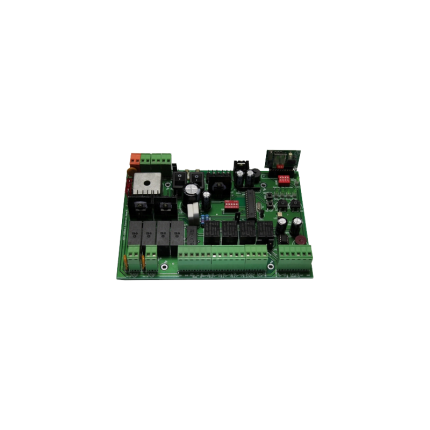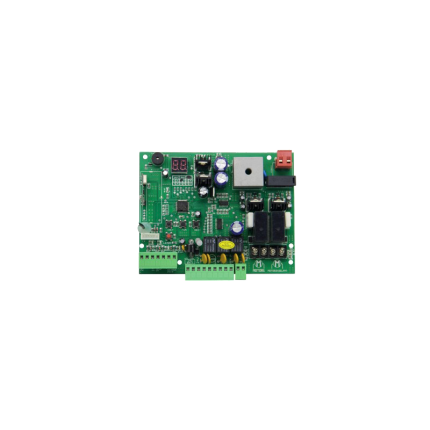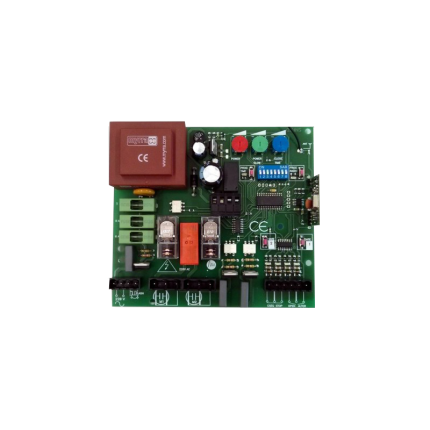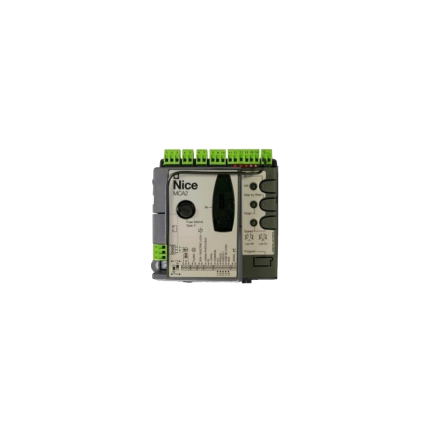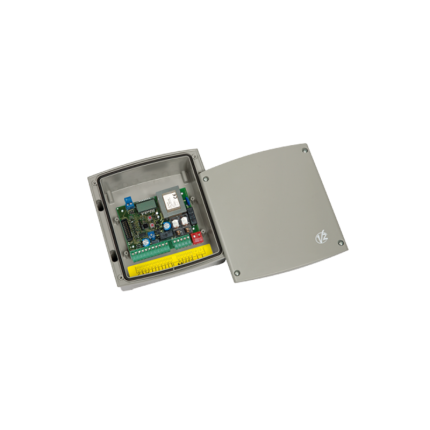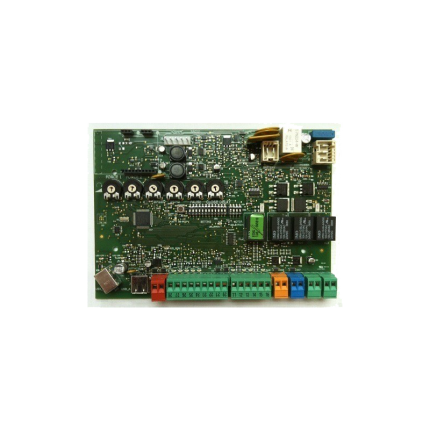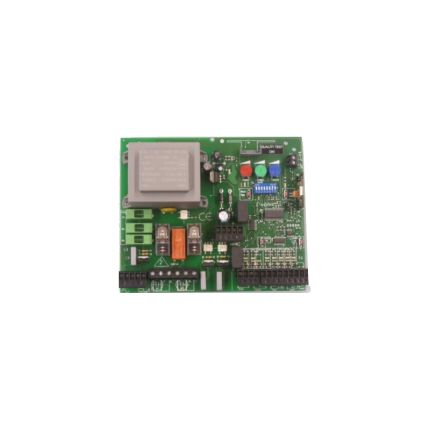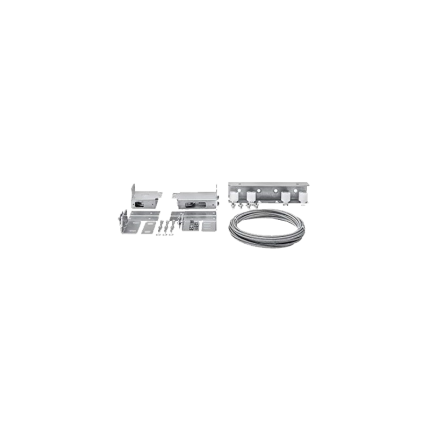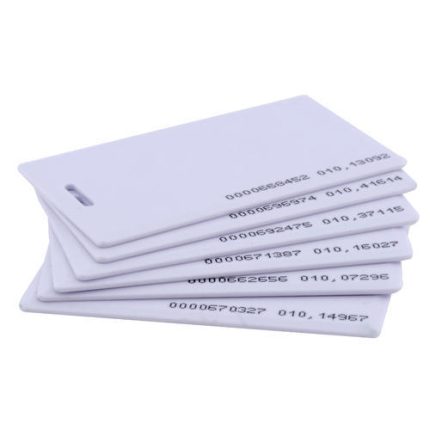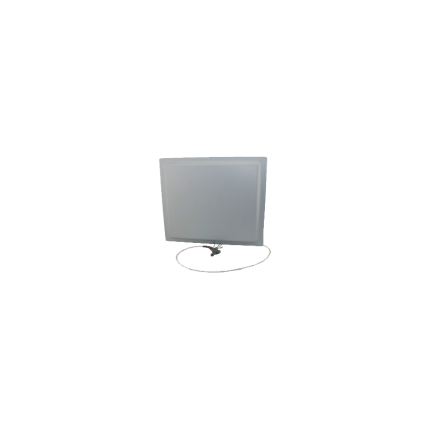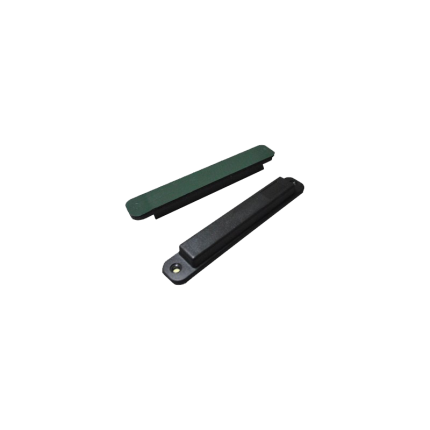Shop
Swing gate operator control board SWRG110
Ship or pick up from our office.
Swing gate operator control board SWRG110
The SWRG110 is a universal swing gate operator control board designed to manage the operation of AC (Alternating Current) powered swing gate motors. It's essentially the "brain" of a swing gate automation system, responsible for controlling the gate's movement, safety features, and integration with various accessories. It's often marketed as a replacement or upgrade board due to its broad compatibility with different AC swing gate openers, particularly those operating at 110V or 220V. Key Features and Functionality The SWRG110, as a universal control board, typically offers a range of features for efficient and safe gate operation:- Motor Control: It manages the power supply and direction of one or two AC gate motors, allowing for opening and closing cycles. It can be used for both single and double swing gates.
- Soft Start/Stop: This feature ensures a smooth and gradual acceleration and deceleration of the gate, reducing wear and tear on the motor and mechanical components, and providing quieter operation.
- Obstacle Detection: A crucial safety feature, obstacle detection allows the gate to stop or reverse if it encounters an obstruction during its movement, preventing damage to the gate, vehicle, or injury to people or pets. This is often achieved through current sensing or external safety sensors like photocells.
- Automatic Close: This function allows the gate to automatically close after a set period of time, enhancing security and convenience.
- Limit Switches: The board interfaces with limit switches (often magnetic or mechanical) to define the full open and full closed positions of the gate, ensuring precise stopping.
- Remote Control Learning: It typically has a learning function to pair with wireless remote controls, allowing users to open and close the gate from a distance.
- Accessory Interfaces: The SWRG110 provides terminals for connecting various gate accessories, such as:
- Photocells/Infrared Sensors: For enhanced safety and obstacle detection.
- Warning Lights: To signal gate movement.
- Keypads/Intercoms: For controlled access.
- GSM Modules/Phone APP integration: Some versions may offer connectivity for remote control via smartphone.
- Wall Buttons: For manual operation from inside the property.
- Exit Wands/Vehicle Sensors: To automatically open the gate for exiting vehicles.
- Adjustable Settings: Many control boards like the SWRG110 offer adjustable parameters, such as:
- Motor power/force (especially for obstacle detection sensitivity).
- Slowdown speed.
- Automatic close timer.
- Working time for each motor.
- Diagnostic Display: Some models include an LED or LCD display for easier setup, programming, and troubleshooting of errors.
- AC Powered Motors: Specifically, 110V or 220V AC swing gate motors. It's not compatible with DC (12V or 24V) motors.
- Various Gate Opener Models: It can replace control boards in numerous existing swing gate openers, such as some ALEKO and Lockmaster models.
- Power Disconnection: Safely disconnecting power to the gate opener.
- Wiring: Connecting the motor, power supply, and accessories to the appropriate terminals on the SWRG110 board. Understanding terminal functions is crucial for correct wiring.
- Programming: Learning remote controls and adjusting settings (e.g., limit switch calibration, auto-close time) according to the specific gate and desired operation.
Swing gate operator control board SWRG24
Ship or pick up from our office.
Swing gate operator control board SWRG24
The SWRG24 is a universal 24V DC main control board for swing gate operators. This means it's designed to be adaptable and compatible with a wide variety of 24-volt direct current swing gate systems, rather than being specific to one brand or model. Here's a breakdown of its key features and functionalities: Key Features- 24V DC Operation: The SWRG24 operates on a 24-volt direct current power supply, which is common in many modern gate systems, especially those that might incorporate battery backup for operation during power outages.
- Universal Compatibility: It's designed to work with various swing gate openers and systems, offering versatility for different installations. This often means it can replace a damaged board in an existing system or be used as the control center for a custom gate setup.
- Programmable and Adjustable Settings: The board is fully programmable, allowing installers and users to customize various operational parameters. These often include:
- Resistance Sensitivity: Adjusts how much force the gate encounters before stopping or reversing, crucial for safety.
- Motor Working Time: Sets the maximum time the motor will run for opening or closing, preventing over-rotation or damage.
- Auto-Closing Time: Configures a delay after opening before the gate automatically closes, enhancing convenience and security.
- Motor Output Power: Allows for fine-tuning the motor's strength to suit the gate's weight and size.
- Soft Start/Stop: This feature typically provides a gradual acceleration and deceleration of the gate, reducing wear and tear on the motor and hardware, and providing smoother operation.
- Quick Close/Anti-Tailgate: Some models may include features to close the gate immediately after a vehicle passes, preventing unauthorized vehicles from following closely behind.
- Digital Display: Many SWRG24 boards feature a digital display (often a digital tube display), which simplifies the process of adjusting settings, troubleshooting, and monitoring the system's status.
- Compatibility with Accessories: It typically has terminals and inputs for connecting a range of safety and access control devices, such as:
- Photocells/Infrared Sensors: Essential safety devices that detect obstructions in the gate's path and prevent it from closing on people or objects.
- Loop Detectors: Used to detect vehicles approaching or exiting the gate, triggering opening or closing.
- Push Buttons/Keypads: For manual operation or coded access.
- Remote Controls: For wireless operation.
- Warning Lights/Alarms: For signaling gate movement or entrapment.
- Safety Compliance: Modern gate control boards like the SWRG24 are often designed to comply with safety standards like UL325, which requires the use of entrapment protection devices.
- Potential for Battery Backup: As a 24V DC system, it's often designed to integrate with battery backup systems, ensuring continued operation during power outages.
- Residential Gates: For homeowners seeking automated access and enhanced security.
- Commercial and Industrial Gates: For businesses and facilities with higher traffic demands, where reliable and secure access is critical.
Swing gate operator main control board – Zero
Ship or pick up from our office.
Swing gate operator main control board - Zero
The "Zero" swing gate operator's main control board is a programmable, multifunctional control unit for swing gates, often used with VDS underground electromechanical motors.
It acts as the "brain" of the system, managing all gate operations and receiving signals from various input devices.
Key features and functions of the Zero swing gate operator's main control board:
-
Central Control:It manages all aspects of the gate operation, acting as the central hub for signals and commands.
-
Signal Processing:Receives signals from remote controls, keypads, safety sensors, and other input devices.
-
Motor Activation:Based on the input received, it sends instructions to the gate motor to open or close the gate.
-
Adjustable Settings:Allows for customization of gate speed, opening/closing times, and safety features.
-
Safety Features:Implements security protocols like locking mechanisms and safety features.
-
Internal Receiver:Many models have a built-in radio receiver for remote control operation, often operating at 433 MHz.
-
Power Supply:Typically operates with a specific voltage input, such as 120V or 24V DC, and may have an output for powering accessories.
-
Compatibility:Some models are designed for universal compatibility with various swing gate openers and systems.
-
Battery Backup:Some models offer battery backup for continued operation during power outages.
-
Other features:May include features like quick close, soft start/stop, and anti-tailgate functions, depending on the specific model.
Swing gate operator main control board – NICE
Ship or pick up from our office.
Swing gate operator main control board – NICE
Nice (formerly also Nice Apollo) offers a range of control boards for their swing gate operators, each with specific features and compatibilities. These control boards are the "brain" of the gate system, managing motor functions, safety features, and access control. Here are some of the prominent Nice swing gate operator main control boards and their general characteristics: Common Nice Control Board Models and Features for the swing gate operator:- Nice Apollo 1050US (and 1050i):
- Features: This is a popular and advanced control board. It typically includes an LCD display for easy programming and diagnostics, a 7-day programmable event timer, and an innovative obstacle detection system. It's designed for seamless integration with a wide array of Nice Apollo gate operators.
- Compatibility: Compatible with various Nice Apollo models, including swing gate openers like the Apollo Linear Actuators, Titan Linear Actuators, and Vanguard 3501. The "US" version (1050US) is UL325 2018 compliant, requiring monitored safety devices, while the "i" version (1050i) does not require them, making it suitable for regions with different safety compliance standards.
- Power: Supports solar, AC power, and backup battery systems.
- Connectivity: Often includes a built-in receiver for remote transmitters and is compatible with Nice BlueBUS safety devices.
- Nice Apollo Mercury 310 (MX4920):
- Features: UL 325 7th Edition compliant with built-in force entrapment protection. It features a solar battery charge controller with MPPT for optimized energy use and plug-and-play functionality.
- Compatibility: Integrated with Nice BlueBUS and OXI accessories, and supports residential linear swing gate actuators.
- Nice Apollo 636:
- Features: Dual 12VDC control for swing and slide gate openers, with obstacle detection and force monitoring for enhanced safety. It integrates BlueBUS for simplified wiring of monitored safety devices and has a programmable dual-gate delay and auto-close. LED feedback aids in diagnostics.
- Compatibility: Works with Apollo Linear Actuators (e.g., Apollo 1500, 1600).
- Nice SmartCNX:
- Features: Designed for modern automation with wireless and cloud connectivity. Offers advanced diagnostic tools for real-time monitoring and troubleshooting.
- Compatibility: Fully compatible with BlueBUS and plug-in safety devices. Customizable settings for motor speed, force, and cycle timing. Works with AC, solar, and battery backup.
- Nice Mindy Series (e.g., A60, A6F, A700f, A824, A924):
- Features: These are older or more specialized control panels, often featuring pull-out terminals, multiple photocell inputs, and microprocessor logic. Some are 24V versions with encoders for precise control.
- Functionality: Offer features like obstacle detection, auto-programming, and self-diagnosis systems.
Swing gate operator main control board – V2
Ship or pick up from our office.
Swing gate operator main control board – V2
The Swing gate operator main control board V2, often referred to as the CALYPSO board, is a crucial component for swing gate automation systems.
It serves as the central hub for controlling the gate's movement, receiving commands from remote controls or other accessories, and directing the gate motor to open or close.
Specifically, this board is designed for use with the VDS underground electromechanical motor and is compatible with gates weighing up to 500 kg.
Key Features and Functions:
-
Central Control:The V2 board acts as the brain of the gate system, receiving signals from various inputs like remote controls or keypads.
-
Signal Processing:It interprets these signals to determine the appropriate action for the gate motor, whether to open, close, or stop.
-
Motor Activation:The board sends instructions to the gate's motor, initiating the opening or closing cycle.
-
Adjustable Settings:It allows for customization of parameters like gate speed, opening and closing times, and safety features.
-
Safety Mechanisms:Many control boards also manage safety features like photo eyes and safety loops, ensuring the gate stops if an obstruction is detected.
-
Communication:It enables communication between the gate motor, safety sensors, and other accessories.
-
Programmability:The board is often programmable, allowing for customization of features and functionality.
-
Compatibility:The V2 board is designed for use with various swing gate operators, including those from LiftMaster and other brands.
In essence, the V2 control board is the central processing unit for your swing gate, ensuring smooth, safe, and reliable operation.
Swing gate operator main control board – VDS (Underground RG24)
Ship or pick up from our office.
Swing gate operator main control board – VDS (Underground RG24)
The swing gate operator main control board for the VDS Underground RG24 is a key component that manages the operation of the gate.
It receives power, processes signals from remote controls and safety devices, and controls the movement of the underground actuator arm to open and close the gate.
The swing gate operator main control board is designed to be fully programmable and compatible with the VDS RG24 underground electromechanical motor, typically with 120V input power.
Here's a more detailed explanation about swing gate operator:
-
Function:The main control board acts as the "brain" of the gate operator system. It receives input from various devices (like remote controls, safety sensors, etc.) and sends appropriate signals to the motor to control the gate's movement.
-
Power Input:The VDS Underground RG24 swing gate operator main control board typically requires a 120V AC input power supply.
-
Programming:It's fully programmable, meaning it can be configured to work with different gate types, safety features, and operational modes.
-
Compatibility:It's designed specifically for the VDS RG24 underground electromechanical motor.
-
Components:The VDS RG24 system typically includes the underground actuator arm and a separate control box that houses the main control board.
-
Safety Features:Modern control boards often include safety features like anti-crushing detection and slowdown capabilities to prevent accidents.
-
Optional Features:Many control boards can be integrated with optional features like battery backup, remote controls, and safety sensors.
Swing gate operator’s main control board – VDS & Difermatic
Ship or pick up from our office.
Swing gate operator main control board - VDS & Difermatic
The swing gate operator main control board is the central processing unit that manages all the functions of the gate opener.
It receives signals from remote controls, keypads, or safety sensors, and then translates these into actions for the gate's motor and other components.
Essentially, it's the brain of the gate operator, coordinating all its movements and safety features.
Here's a more detailed look at its functions:
-
Signal Processing:The main control board receives input from various sources like remote controls, keypads, or safety sensors.
-
Motor Control:Based on the input, it sends signals to the gate's motor to open or close the gate.
-
Adjustable Settings:Many main control boards allow for adjustments to settings like gate speed, opening/closing times, and safety features.
-
Safety Features:It manages safety mechanisms like obstruction detection, which stops or reverses the gate if it encounters an obstacle.
-
Access Control:It can manage access by integrating with keypads, intercoms, and other access control systems.
-
Power Management:The main control board manages the power supply to the motor and other components, including battery backup systems for power outages.
-
Communication:It can also communicate with other devices and systems, like alarm systems, for enhanced security.
-
Universal Compatibility:Some main control boards, like the SWRG24, are designed to be compatible with a wide range of swing gate openers and systems.
Telescopic sliding gate hardware
Ship or pick up from our office.
Telescopic sliding gate hardware
UHF Card
Ship or pick up from our office.
UHF Card
UHF (Ultra High Frequency) Card Access Control is a system that uses Ultra High Frequency Radio-Frequency Identification (UHF RFID) technology for managing and controlling access to various areas. Unlike traditional access control systems that require a close proximity tap or swipe, UHF systems leverage the longer read range of UHF RFID to provide hands-free, faster, and more efficient access. How it Works ⚙️ The core components of a UHF Card Access Control system are:- UHF Cards/Tags: These are typically cards, key fobs, or even vehicle tags embedded with a UHF RFID inlay. They contain a unique identification number or other encoded data.
- UHF Readers: These devices emit radio waves in the UHF frequency range (typically 860-960 MHz). When a UHF card/tag enters the reader's range, the tag is powered by the radio waves and transmits its unique data back to the reader.
- Antennas: Integrated within or connected to the readers, these are responsible for transmitting and receiving the radio signals.
- Access Control Software/System: This software receives the data from the reader, verifies the tag's credentials against a database, and then grants or denies access based on predefined rules. If access is granted, it sends a signal to unlock a door, open a gate, etc.
- Tag enters field: A person with a UHF card or a vehicle with a UHF tag approaches the reader.
- Reader transmits signal: The UHF reader continuously emits radio waves.
- Tag responds: The passive UHF tag, powered by the reader's signal, transmits its unique ID back.
- Data received and processed: The reader captures the tag's data and sends it to the access control system.
- Access granted/denied: The system verifies the credentials and, if authorized, activates the access point (e.g., opens a barrier). This entire process happens wirelessly and often within milliseconds.
- Long Read Range: Unlike Low Frequency (LF) and High Frequency (HF) RFID systems, UHF can read tags from several meters away (up to 10-15 meters or more depending on the setup). This allows for hands-free access, such as for vehicles entering a parking lot or individuals walking through a gate without stopping.
- High-Speed Data Transmission and Multiple Tag Reading: UHF readers can read many tags simultaneously and quickly (hundreds of tags per second). This is crucial for high-traffic areas, reducing bottlenecks and improving efficiency.
- Convenience and Efficiency: Users don't need to physically present or swipe a card, leading to a smoother and faster access experience. This is especially beneficial in applications like vehicle access, parking management, and large event entry.
- Enhanced Security: UHF tags are difficult to counterfeit, and the systems often incorporate encryption and password protection to prevent unauthorized access and data manipulation. Real-time tracking capabilities can also enhance security oversight.
- Scalability and Centralized Management: Cloud-based UHF access control platforms allow administrators to manage users, permissions, and access points remotely and in real-time, making it easy to scale for larger organizations or multiple locations.
- Durability and Cost-Effectiveness (Long Term): UHF components are generally robust and durable, leading to lower maintenance and replacement costs over time compared to traditional systems.
- Low Frequency (LF) RFID (125-134 kHz):
- Read Range: Very short (typically a few centimeters).
- Characteristics: Less susceptible to interference from metal and liquids.
- Common Uses: Animal identification, car immobilizers, older access control systems where close proximity is acceptable.
- High Frequency (HF) RFID (13.56 MHz):
- Read Range: Short (up to 1 meter).
- Characteristics: Good for secure data transfer and applications requiring closer interaction. Often used with Near Field Communication (NFC).
- Common Uses: Contactless payments (e.g., Apple Pay, Google Pay), smart cards for building access, public transport ticketing, library systems.
- Ultra High Frequency (UHF) RFID (860-960 MHz):
- Read Range: Long (several meters up to 15+ meters).
- Characteristics: Ideal for long-range, high-speed identification of multiple items. More susceptible to interference from metals and liquids than LF/HF, though specialized tags and antenna designs can mitigate this. The industry standard for passive UHF RFID is often referred to as RAIN RFID.
- Common Uses: Vehicle access control, inventory management, supply chain tracking, asset tracking, automated toll collection, large-scale personnel tracking.
UHF Gate Controller
Ship or pick up from our office.
UHF Gate Controller
A UHF Gate Controller is a system that uses Ultra-High Frequency (UHF) Radio Frequency Identification (RFID) technology to manage and control access through a gate or designated entry/exit point. It typically consists of a UHF RFID reader, antennas, and a control unit that processes the data and triggers the gate mechanism. It's designed for automated, hands-free identification and tracking of people or objects equipped with UHF RFID tags, offering a longer read range and faster processing compared to other RFID frequencies. How it Works The fundamental principle of a UHF Gate Controller relies on the interaction between a UHF RFID reader and UHF RFID tags. Here's a breakdown:- UHF RFID Reader and Antennas: The gate controller incorporates a UHF RFID reader connected to one or more antennas. These antennas emit radio waves in the UHF frequency band (typically 860-960 MHz).
- RFID Tags: People, vehicles, or items needing access are equipped with UHF RFID tags. These tags contain a microchip that stores data (like a unique ID) and an antenna. Passive UHF tags, which are common in these systems, do not have their own power source; they draw power from the radio waves emitted by the reader.
- Data Exchange: When a tagged item or person enters the read range of the gate's antennas, the RFID tag is energized by the reader's radio waves. The tag then modulates these waves to send its stored data back to the reader.
- Data Processing and Control: The UHF RFID reader receives the tag's data and sends it to a control unit (often an integrated part of the gate system or a separate access controller). This control unit verifies the tag's information against a database of authorized entries.
- Gate Activation: If the tag is authorized, the control unit sends a signal to open or enable the gate (e.g., a barrier arm, turnstile, or door lock). If the tag is unauthorized, access is denied, and an alarm might be triggered.
- Directional Detection and Anti-Collision: Advanced UHF gate controllers can detect the direction of movement (e.g., entering or exiting) and employ anti-collision algorithms to read multiple tags simultaneously, even in high-traffic scenarios. Some systems use additional sensors (like infrared) to improve accuracy and prevent "tailgating."
- Long Read Range: Typically able to read tags from several meters away, allowing for "hands-free" and "drive-through" access.
- High Reading Speed: Can quickly identify multiple tags in motion, reducing bottlenecks.
- Anti-Collision: Algorithms that allow the reader to differentiate and read multiple tags present in the field at the same time.
- Directional Sensing: Ability to determine if an item or person is entering or exiting the controlled area.
- Integration Capabilities: Often connect with other security or management systems via interfaces like Ethernet, RS232, RS485, or Wi-Fi.
- Robust Design: Many are built for industrial or outdoor environments, with resistance to dust and water.
- Vehicle Access Control: Managing entry and exit for parking lots, gated communities, corporate campuses, and toll roads. Vehicles can have tags on windshields, allowing for seamless, hands-free access.
- People Access Control: Controlling access to buildings, restricted areas, and for time and attendance tracking in offices, universities, hospitals, and event venues.
- Logistics and Warehouse Management: Monitoring the flow of goods, pallets, and containers in and out of warehouses, distribution centers, and production lines for inventory management, asset tracking, and theft prevention.
- Retail: Used at store exits for Electronic Article Surveillance (EAS) to prevent shoplifting, and for inventory tracking as items move in and out of the backroom.
- Libraries and Document Management: Tracking books, documents, and other assets as they enter or leave a facility.
- Manufacturing: Monitoring materials and finished products on production lines and at factory entrances/exits.
UHF Label
Ship or pick up from our office.
UHF Label
A UHF (Ultra-High Frequency) label access control system uses radio-frequency identification (RFID) technology operating in the ultra-high frequency range (typically 860-960 MHz) to manage and control access to specific areas, buildings, or resources. It's a touchless, automated system that offers long-range reading capabilities and the ability to identify multiple items simultaneously, making it highly efficient for various applications like vehicle access, personnel tracking in large facilities, and event management. 🛂 How it Works The core principle of a UHF label access control system relies on the communication between RFID tags (labels) and RFID readers. Here's a breakdown of the process:- RFID Tags (Labels): These are small electronic devices, often in the form of adhesive labels, cards, or embedded devices. They contain a microchip that stores unique identification data and an antenna. Most UHF tags used in access control are passive, meaning they don't have their own power source and rely on the energy emitted by the reader.
- RFID Reader: The reader emits radio waves, creating an electromagnetic field. When a UHF RFID tag enters this field, it absorbs energy from the waves, which powers its microchip.
- Data Transmission: Once activated, the tag modulates the waves to transmit its stored data (its unique ID) back to the reader.
- Data Processing and Verification: The reader captures and decodes this data, then sends it to a central access control system (often a computer with specialized software and a backend database). The system verifies the tag's unique ID against a list of authorized credentials and pre-defined access rules.
- Access Granting/Denial: If the tag is authorized, the system sends a signal to unlock a door, open a gate, or grant access. If not authorized, access is denied, and the system may trigger an alarm or log the attempted entry.
- Logging: The system typically records all entry and exit events, providing a detailed audit trail for security and management purposes.
- UHF RFID Tags/Labels: These are the physical identifiers worn by individuals or attached to vehicles/assets. They store the unique ID and are read by the system.
- UHF RFID Readers: These devices emit radio waves to power and read the data from the tags. They are strategically installed at entry/exit points (e.g., doorways, gates). Fixed readers are common for specific zones, while handheld readers offer flexibility for mobile applications like inventory or searching for tags.
- Antennas: Connected to the readers, antennas are responsible for transmitting and receiving the radio signals. The type and placement of antennas affect the read range and coverage area.
- Access Control Software/System: This is the "brain" of the system. It manages the database of authorized tags, processes the data received from readers, applies access rules, and controls the locking mechanisms. It often integrates with other security or building management systems.
- Backend Database: Stores all the information related to RFID tags, authorized users, access levels, and event logs.
- Locking Mechanisms: These are the physical devices controlled by the system, such as electronic door locks, gate barriers, or turnstiles.
- Long Read Range 📏: UHF systems can read tags from several meters away (typically 3-10 meters, and sometimes up to 25 meters or more), allowing for hands-free and rapid access, particularly useful for vehicles or large volumes of people.
- High-Speed Data Transmission and Multi-Tag Reading ⚡: They can read multiple tags simultaneously (often over 100 tags per second), significantly improving efficiency in high-traffic areas and during events.
- Enhanced Efficiency ⏱️: Automation of access eliminates manual checks, reduces queuing times, and frees up staff for other tasks.
- Improved Security 🔒: Each tag has a unique identifier, making it difficult to forge or duplicate. The system provides real-time monitoring and detailed audit trails, enhancing accountability and security. Integration with other systems like surveillance cameras can further bolster security.
- Touchless Operation 🖐️: The long read range enables touchless access, which is beneficial for hygiene, particularly in high-traffic areas or environments where physical contact should be minimized.
- Scalability 📈: UHF RFID systems can be easily scaled to accommodate a growing number of users and access points without compromising performance.
- Durability and Resistance 💪: UHF tags are often resistant to environmental factors like water, oil, and chemicals, and the data stored on their chips is protected. They can also be reused.
- Reduced Wear and Tear: As there's no physical contact with readers, the system components experience less wear and tear, leading to lower maintenance costs.
UHF Licence Plate
Ship or pick up from our office.
UHF Licence Plate
A UHF (Ultra High Frequency) Licence Plate access control system is a vehicle identification and access management solution that uses UHF RFID (Radio Frequency Identification) technology to automatically grant or deny entry to vehicles. Instead of relying on traditional license plate recognition (ANPR/LPR) which uses cameras to read visible plates, UHF systems use RFID tags, often in the form of stickers or cards, affixed to vehicles. 🚗 When a vehicle with a registered UHF RFID tag approaches an access point (like a gate or barrier), a UHF reader emits radio waves. The tag, powered by these waves, transmits its unique identification data back to the reader. This data is then sent to an access control system which verifies the vehicle's authorization. If authorized, the system triggers the gate to open, allowing for fast, hands-free, and seamless entry and exit. This technology is widely used in places requiring efficient and secure vehicle flow, such as:- Gated communities 🏡
- Parking facilities (corporate, commercial, residential) 🅿️
- Industrial sites and logistics hubs 🏭
- Toll roads 🛣️
- UHF RFID Tags: These are small, passive (battery-less) or semi-active devices that contain a microchip storing a unique identification number and an antenna. They are typically affixed to the vehicle's windshield or license plate. When exposed to radio waves from a reader, the tag's antenna collects energy, powering the microchip to transmit its data.
- UHF RFID Readers: These devices are installed at access points (e.g., gate entrances) and emit radio waves to detect and read the RFID tags on approaching vehicles. They have antennas to send and receive signals, and a processor to decode the data from the tags. UHF readers typically have a longer read range (up to 10-12 meters or more) compared to other RFID frequencies, allowing vehicles to pass without fully stopping.
- Access Control System (Software/Controller): This is the "brain" of the system. The reader sends the tag's ID number to this system. The access control software then compares this ID with its database of authorized vehicles. Based on pre-defined criteria (e.g., specific times of day, authorized user groups), it determines whether to grant or deny access.
- Barrier/Gate System: If access is granted by the control system, a signal is sent to the physical barrier (like a boom gate or sliding gate), which opens to allow the vehicle to pass.
- Speed and Efficiency 🚀: Vehicles don't need to stop or roll down windows, significantly reducing traffic congestion, especially during peak hours. This provides a "frictionless" entry experience.
- Long Read Range 📏: UHF RFID allows for detection from several meters away, enabling quick processing of vehicles even at higher speeds.
- Reliability in Diverse Conditions 🌧️☀️: Unlike optical ANPR systems that can be affected by dirt, rain, snow, or poor lighting, UHF RFID tags are generally more robust and less susceptible to environmental factors.
- Enhanced Security 🔒: RFID tags are difficult to duplicate or tamper with, offering a higher level of security than some other methods. The system also logs all entries and exits, providing a clear audit trail.
- Reduced Operational Costs 💰: Automation minimizes the need for manual gate attendants, leading to lower labor costs over time. There's also no need for physical cards or key fobs that can be lost or damaged, saving on replacement costs.
- Integration Capabilities 🔗: These systems can often integrate seamlessly with other security and management platforms, such as visitor management systems, surveillance cameras, and parking management software, for a comprehensive solution.

